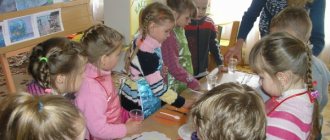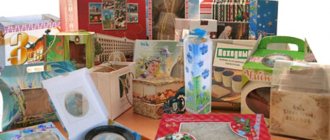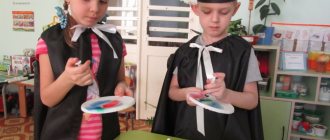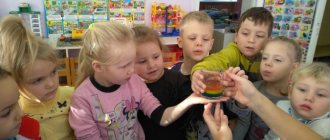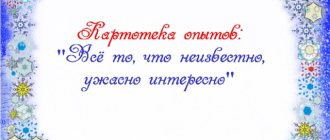Maria Savchenko
Experimental activities in the preparatory group. How to create a rainbow
Introduction
Every person at least once in his life admired a natural miracle - a rainbow . Many people have probably noticed that rainbows usually appear after rain. a rainbow many times , I wanted to know what a rainbow and how it appears, whether it is possible to get a rainbow artificially at home.
Purpose of the study: to find out whether it is possible to get a rainbow at home .
The object of study is the natural phenomenon of the rainbow .
The subject of the study is the types of rainbows and the possibility of obtaining them artificially.
Research problem: how to create different types of rainbows at home ?
Research objectives:
1. Find out what a rainbow and how it appears.
2. what types of rainbows exist in nature and is it possible to obtain them artificially?
3. Conduct experiments on obtaining a rainbow at home .
Hypothesis:
Let's assume that a rainbow can be obtained by replacing the sun's rays:
1. artificial light - lamp,
2. using water and felt-tip pens.
3. using Skitels
I have chosen will allow you to see a rainbow at home .
Basic methods: literature study, observation, experiment.
1.Relevance:
How does a rainbow ?
Since my senior year I have known the saying “Every hunter wants to know where the pheasant sits. From the initial letters of these sayings, I remembered the names and sequence of colors of such an unusual and beautiful natural phenomenon as a rainbow . Why does such a beautiful, and even colorful, picture appear in the air? Together with my teacher, we looked for the answer to this question in the encyclopedia, the Internet, and watched educational cartoons about rainbows . We learned that rainbows can be seen near waterfalls, fountains, and sprinklers.
Conclusion: a rainbow appears in sunny weather during rain, when the sun's rays pass through raindrops.
2. What types of rainbows exist .
a rainbow in the encyclopedia , I decided to find out what other rainbows exist .
A winter rainbow is a very rare phenomenon, because the refraction of sunlight occurs not in water droplets, but in ice crystals.
Hazy or white rainbow
It appears when a faint fog consisting of small droplets is illuminated by sunlight.
Red rainbow
In the last five or ten minutes before sunset, all the colors of the rainbow except red begin to disappear and finally only a single red arc remains.
Practical part
Rainbow is a miracle of nature . Is it possible to create this miracle yourself , at home? I decided to try this and conducted several experiments together with my teacher.
Experience No. 1 “ Creating a rainbow at home ”
Myths about the rainbow
Rainbow is a magnificent colorful phenomenon that has long captured the imagination of people. Looking at a rainbow, you want to believe in miracles and magic. Maybe that's why humanity has associated the rainbow with many myths and legends.
In Christianity, the rainbow symbolized forgiveness, a contract between God and man, a sign that from now on there will be no more global flood.
In the Christian symbolism of the Middle Ages, the three main colors of the rainbow are interpreted as images of the global flood (blue), global fire (red) and the new earth (green).
In China, they believed that the rainbow was a heavenly dragon, the union of Heaven and Earth.
The Western Slavs have a belief that a witch can steal a rainbow and hide it, which means causing drought on the earth.
The Irish leprechaun hides a pot of gold in the place where the rainbow touched the ground.
According to the beliefs of many African peoples, the rainbow is a heavenly snake that serves as a guardian of treasures, and in those places where the rainbow touches the ground, treasure can be found.
And in the mythology of the Australian aborigines, the Rainbow Serpent is considered the patron of water and rain.
How to explain "Rainbow" to preschoolers
An interesting lesson should be completed by explaining the properties of water. The teacher can tell the children that the denser the material - paper compared to a napkin - the slower it gets wet. Therefore, the dots from felt-tip pens take longer to spread.
The description of the “Rainbow in a Glass” experiment for children in the second version includes the following explanation: light consists of a full spectrum of colors, and with the help of a mirror it breaks up into its component parts.
In the third experiment, you need to tell that the more sugar or salt is dissolved in a glass, the denser the liquid becomes. This is why the colors don't mix.
The meaning of the word "rainbow" in encyclopedic dictionaries
From the Explanatory Dictionary of the Russian Language by S.I. Ozhegov. , we learned that:
A rainbow is a multi-colored arc in the sky, formed as a result of the refraction of sunlight in raindrops.
According to the New Encyclopedic Dictionary of Brockhaus and Efron:
Rainbow is a well-known optical phenomenon in the atmosphere; observed when the sun illuminates a sheet of falling rain and the observer is between the sun and the rain. This phenomenon appears in the form of one, or less often, two concentric light arcs drawn in the sky from the direction of falling rain and colored flowers.
The inner, most often visible arc is colored red on the outer edge and violet on the inner edge; Between them, in the usual order of the solar spectrum, lie the colors: red, orange, yellow, green, blue and violet. The second, less frequently observed arc lies above the first, is usually more weakly colored, and the order of the colors in it is reversed.
According to V. Dahl's dictionary:
Rainbow is a modified version of the word "rayduga", or God's arc.
Step-by-step instructions for the “Rainbow in a Glass” experiment for children
The teacher tells the group that during the trick you will get three rainbows at once. They will be different, but any of them can be repeated with parents at home.
For the first experiment, kids cut out strips 5 cm wide from a napkin and thick cardboard. At a distance of 3 cm from the edge of each of them, draw a transverse line with a simple pencil. Children put dots on them with felt-tip pens in 7 colors of the rainbow.
Strips of paper are lowered into the water so that it does not reach the points by 1 cm. After a few minutes, the colors on the napkin spread. This happens more slowly on thick paper.
The description of the “Rainbow in a Glass” experiment for children in the second version will require turning off the lamps in the group. The teacher lowers the mirror halfway into a glass or other container with water. Children point a flashlight at it and see where the rainbow appears. You can try to catch it on a piece of paper.
Step-by-step instructions for the third experiment “Rainbow in a glass” are more complex:
- Arrange the cups in a row according to the number of dyes. Leave the first empty, put one spoon of sugar or salt in the second, 2 in the third, 3 in the fourth, and so on.
- Add 45 ml of warm water to all glasses and dissolve the contents in it. The main thing is not to confuse the order.
- Add food coloring or gouache and mix. Add a couple of drops of red to the container with the largest amount of sugar, orange, yellow to the next, and so on.
- Using a syringe, carefully fill an empty glass with colorful liquids in order. Different densities will prevent them from mixing.
To share the children’s successes with parents, you can film the “Rainbow in a Glass” experiment conducted in kindergarten or take vivid photographs of the participants with the results of the experiments.
How many colors does the rainbow have?
Rainbows have always been seen differently in different periods of history and in different peoples. It distinguished three primary colors, and four, and five, and as many as you like.
The first to explain the nature of the rainbow was Aristotle. He determined that “a rainbow is an optical phenomenon, not a material object.” Aristotle identified only three colors: red, green, violet.
The Rainbow Serpent of the Australian Aborigines was six-colored. Some African tribes see only two colors in the rainbow - dark and light.
Although the phenomenon of the rainbow was explained by the refraction of sun rays in raindrops back in 1267, Roger Bacon, but only Newton thought of analyzing the light and, at first, he counted five colors: red, yellow, green, blue, violet. But later, having seen another color (orange), he considered it a theological obsession (the number 6 was unlucky for him) and, trying to create a correspondence between the number of colors of the spectrum, the number of basic tones of the musical scale and the number of days of the week, Newton added to the six listed colors of the spectrum another one is indigo (blue).
Isaac Newton proved that ordinary white color is a mixture of rays of different colors. (Annex 1)
So Newton became the “father” of the seven-color rainbow.
Abstract of OOD "RADUGA - DUGA"
Summary of a lesson on cognitive and research activities for preschoolers “RAINBOW - ARC”
Educator: Sesoreva M.A.
Target:
Development of children's research abilities, consolidation of knowledge about the colors of the rainbow.
Objectives:
• Improve the ability to observe and analyze objects of the surrounding world;
• Develop a desire to participate in creative activities; • To cultivate a positive emotional and value-based attitude towards the world around us, Plan:
1. Conversation “Fairytale Rainbow” 2. Learning the acrostic phrase “Every Hunter...” 3. Experience-experiment “Rainbow on a disk” 4. Drawing “Flower - seven-colored” 5 .Reading: “The Legend of a Boy Named Rainbow”
Lesson progress: MORNING 1. CONVERSATION “A FANTASTIC RAINBOW”
The rainbow is one of the most fabulous phenomena of nature. Rainbow is
companion of the rain. A rainbow can appear before the rain, during the rain, and after the rain stops.
What is a rainbow? A rainbow is an arc of color. It can be seen against the background of the rain. A rainbow is observed in the side of the sky that is opposite to the sun, while the sun is not covered by clouds. Most often, such conditions are created in the summer, during the so-called “mushroom” rains. There are seven colors in the rainbow. - Where else besides the sky can you see a rainbow? (children's answers)
— A rainbow can be seen near a fountain or waterfall, against the background of drops from a sprinkler.
A rainbow can be seen at a time when the Sun is shining in parallel with the rain. To see it, you need to be strictly between the Sun and the rain. In this case, the Sun should be behind, and the rain should be in front. —Where does the amazing colorful light emanating from a rainbow come from? The source of the rainbow is sunlight. This light moves across the sky in such a way that it appears to come from that part of the sky that is opposite to the Sun. 2. LEARNING THE ACROSTIC PHRASE “EVERY HUNTER...”
Everyone is Red;
Hunter - Orange; Wishes - Yellow; Know - Green; Where - Blue; Sitting - Blue; Pheasant - Purple. 3. EXPERIMENT “RAINBOW IN A GLASS” (using a CD)
- Take the CD and wipe it so that it is not dusty.
- Place it on a flat surface, under a light or in front of a window. - Look at the disk and enjoy the rainbow. You can spin the dial to see how the colors move. 4. DRAWING “FLOWER – SEMIFLOWER
5.READING:
"The LEGEND OF A BOY NAMED RAINBOW"
This happened in the old, old days. At that time there was only one large island on Earth in the middle of the ocean. And colorful people lived on this island. They did not have a school, so they were all ill-mannered, greedy and evil. Multi-colored people constantly argued with each other, were mischievous, and called names. One day a boy with silver skin and golden hair appeared on this island. His name was Rainbow. He was the son of the Sun and Cloud. Rainbow always looked down on people and really wanted to get to know them. He didn't know what they really were. Multi-colored people seemed very beautiful, cheerful and friendly to him. The boy spent a long time trying to persuade his parents to let him go to Earth. And finally, he received permission and found himself on the island among people. He happily walked down the street and said hello to everyone he met. But in response, people were rude to him, teased him and laughed evilly. The rainbow came to a large area. There were a lot of colorful people here. And all of them, as always, shouted and called names, some even fought. The boy was very upset. Now people seemed scary, crooked and evil to him. Rainbow wanted to run away, to return home to her parents. But he was a very kind boy and decided to reconcile all the colorful people. “They need to see themselves from the outside, how scary and ugly they are,” thought Rainbow. “But how to do this?” In those days there was no mirror on Earth. Then the boy came up with the idea: “We need to draw them!” But Rainbow did not yet know how to draw large pictures, and the only artist on the island did not agree to teach him. But Rainbow did not give up. Every day he began to go to the garden, where the only artist painted his paintings. The boy hid in the bushes and carefully watched the work of the only artist. Then Rainbow took the brushes and paints that he begged from his Aunt Nature and tried to paint. That's how I learned. Time passed. And then one day Rainbow woke up and realized that he was ready to paint his picture. He worked for a long time. I walked the streets, observed and drew, observed and drew. And now, the picture is ready! Rainbow installed it in the largest area and covered it with a black blanket until the morning. And he went to bed. But the colorful people did not sleep that night. They have long wanted to somehow harm this good-natured Rainbow. And so, when the picture appeared on the square, they came up with a cruel joke. Multi-colored people made their way into the square, pulled the black cover off the painting and poured black paint on it. They were so busy with their villainy that they did not even look at what was painted in the picture. In the morning Rainbow ran to the square and wanted to remove the black cover from the painting. But it was not filmed. The boy was surprised, but then he realized what had happened and began to cry. And colorful people stood around and laughed. Then they started spraying him with colorful paints. Everything was dirty. Rainbow could not stand this and asked his parents to take him home. At home, Rainbow washed off all the paint, but he couldn’t wash his hair. So they remained colorful. Then the boy told his parents everything and asked his mother Tuchka to wash off the black paint from the picture, and his father Sun to illuminate the picture brightly. Let colorful people look at themselves from the outside. Mom Cloud and dad Sun fulfilled their son’s request. The colorful people were still in the square. They screamed and argued, fought and bit. And they didn’t even notice how Tuchka’s mother came and washed off the black paint from the painting with the rain. But then Father Sun appeared and illuminated his son’s picture brightly. The noise slowly began to subside. And suddenly all the colorful people turned red. Everyone saw themselves in the picture. And they all felt very, very ashamed. Everyone stood and was silent. Then Father Sun decided that colorful people were too different from each other. It will be better if they become one color. It began to shine brighter and brighter, burning people and tanning them. But some people stood in the very sun and became dark brown, others were in the shade and their skin became white, and others became yellowish. This is how three races appeared on Earth: blacks, Europeans and Mongols. But the Sun not only repainted people, but also made their hearts warm and kind. Since then, all people on Earth have become friends. Then the only large island was divided into several islands, but the friendship between such different people does not stop. And every time when mother Cloud washes the Earth, and father Sun illuminates it, the boy Rainbow looks at people, so different, but friendly and happy, and rejoices. And with joy, his hair begins to shimmer with multi-colored colors, and a rainbow appears in the sky.
The appearance of rainbows in nature
Rainbows can be seen before or after rain. And only if, at the same time as the rain, the sun breaks through the clouds. The sun's rays pass through raindrops. And each such droplet divides the white light of the Sun into its components - rays of red, orange, yellow, green, blue, indigo and violet. Moreover, droplets deflect light of different colors in different ways, as a result of which white light is decomposed into a multi-colored band, which is called a spectrum. (Appendix 2)
The shape of a rainbow is determined by the shape of the water droplets (they are more or less round) in which sunlight is refracted. Therefore, to an observer on earth, a rainbow usually looks like an arc - part of a circle.
You can only see a rainbow if you are strictly between the sun and the rain.
Sometimes you can see another, less bright rainbow around the first one. This is a secondary rainbow, in which the light is reflected twice in the drop. In a secondary rainbow, the order of colors is “inverted” - purple is on the outside and red is on the inside.
The appearance of the rainbow, the brightness of the colors, and the width of the stripes depend on the size and number of droplets in the air. The larger the raindrops, the brighter the rainbow. If the drops are small, the rainbow appears pale and barely noticeable.
However, rainbows can be seen not only after rain. In winter, when there is severe frost, ice crystals “float” in the air. They can also divide white into the seven colors of the rainbow, so rainbows can be seen even in winter. Although this phenomenon is quite rare.
Description of the experience
For many experiments, ingredients that are found in any home are enough. Rainbow in a glass is an experience for children that will introduce them to the properties of water. This theme combines three different experiences that can be carried out in a kindergarten group or at home. They do not require special devices or reagents, and the participants will love the multi-colored result of the trick. The first experiment reveals the concept of water density, the second - the absorbency of paper, and the third - the refraction of light.
A description of the “Rainbow in a Glass” experiment for children can be found in video format; its preparation requires a little time and gouache or food coloring of several colors.
Rainbow experimentally
In order to make sure that there really are seven colors in the rainbow, and to investigate this natural phenomenon, we conducted a series of experiments. (Appendix 3)
Experiment 1. Artificial rainbow
Required material:
A container of water, a sheet of white paper, a flashlight, a mirror.
Progress of the experiment:
Pour water into the container and lower the mirror to the bottom. We direct the light of the flashlight onto the mirror. The reflected beam of light must be “caught” on the paper. Due to the refraction of the ray, a rainbow appears on the sheet.
Explanation:
A ray of light consists of several colors; when it passes through water, it is decomposed into its component parts - the seven colors of the rainbow.
Experiment 2. Rainbow soap bubbles
Required material:
Container with soapy water, device for blowing bubbles.
Progress of the experiment:
We take the device, dip it in a container of soapy foam and blow out the bubbles.
You can see a seven-color rainbow on the bubbles flying in the air.
Explanation:
Rays of light hitting the bubble are refracted and produce beautiful rainbow colored rings, which Isaac Newton was the first to study.
Experiment 3. Decomposition of white light into a spectrum using a CD
Required material:
CD, white paper, flashlight.
Progress of the experiment:
Let's take a disk. Let's point a flashlight at it so that rays of light fall on its mirror surface. We direct the light using a disk onto a white sheet of paper. We change the tilt of the CD, and then we can see many “rainbow” patterns.
Explanation:
Light is refracted on the mirror surface of the disk, similar to the refraction of sunlight in a drop of water. That's why we can see a rainbow.
Experiment 4. How to get white from a Rainbow
Required material:
A paper circle painted in seven colors of the rainbow; match - axle.
Progress of the experiment:
We make an axis from a match in the center of the paper circle. We begin to rotate quickly. Instead of a colored circle, we will see a white one.
Explanation:
The human eye cannot see each color separately on a rapidly rotating circle, and for it all colors merge into one white color.
Experience 5. Rainbow on the phone
Required material:
Telephone, table lamp, CD.
Progress of the experiment:
We shine a lamp on the mirror surface of the disk. Turn on the camera on your phone and point it at the disk. A rainbow appears over the entire surface of the disk.
Explanation:
The phone's camera, like our eye, perceives light. The disk splits the white light of a flashlight into seven colors of the spectrum. Therefore, we can observe a rainbow on the mirror surface of the disk through the phone camera.
Conclusion
At the beginning of our work, we made the assumption that a rainbow in nature appears only after rain and has seven colors.
While studying the literature, we found out that raindrops can divide white into seven colors of the spectrum, but only when the sun is shining.
In the course of practical experiments, we found that there are several ways to experimentally form a rainbow, and that a rainbow actually has seven colors: red, orange, yellow, green, blue, indigo and violet.
Therefore, the following conclusions can be drawn:
- Rainbows are a natural phenomenon, the study of which requires a lot of effort and is very interesting.
- The main condition for the appearance of a rainbow in nature is the presence of sunlight and rain.
- Obtaining a rainbow experimentally allows for a more detailed study of this rainbow.
The practical part of this work is that by acquiring information about a previously unstudied topic, you can not only enrich your own knowledge, learn to obtain knowledge from additional sources, analyze the material received, but also share your results with peers who, in our opinion, benefit from this topic will be interesting.
Thanks to such work, activity in the cognitive sphere of activity increases, which is the main factor for the development of the student’s personality.
Bibliography
- Dal V.I. Explanatory dictionary of the Russian language. Modern version. - M.: ZAO Publishing House EKSMO - Press, 2000. - 736 p.
- Zubkova N.M. A cart and a small cart of miracles. Experiments and experiments for children. – St. Petersburg: Rech, 2006.-64 p.
- Levkievskaya E. E. Myths of the peoples of the world. - M.: Astrel, 2000. - P. 90. - 528 p.
- New encyclopedic dictionary / Under the general. ed. acad. K.K. Arsenyeva. - St. Petersburg: Publishing house F. A. Brockhaus and I. A. Efron, 1911-1916. - T. 26.
- Newton I. Optics or treatise on reflections, refractions, bendings and colors of light / Translation by S. I. Vavilov - 2nd ed. - M.: State. Publishing house of technical and theoretical literature, 1954. - P. 131. - 367 p.
- Ozhegov S.I., Shvedova N.Yu. Explanatory dictionary of the Russian language: 80,000 words and phraseological expressions / Russian Academy of Sciences. Institute of Russian Language named after. V. V. Vinogradova. — 4th ed., supplemented. - M.: Azbukovnik, 1999. - 944 p.
- Yakovleva M.A. Fun science experiments for kids and adults. Experiments in the room. – M.: Eksmo, 2012. – 64 p.
Appendix 1. Newton's Color Spectrum
Preparatory stage
To conduct the “Rainbow in a Glass” experiment in kindergarten, the teacher can learn a rhyme with the group that helps them remember the order of the colors of the rainbow. This will be the main spell. Let the kids taste the water, decide what color it is, add a little color and mix. They will see that the liquid completely changes color. Experimentation will teach children to be careful when handling water, develop fine motor skills and reasoning skills.
What will you need for the experiment?
To demonstrate the Rainbow in a Glass experiment for preschoolers, some simple preparations are required. Each participant must have the following set on the table:
- granulated sugar or salt, about 0.5 kg;
- 6 plastic cups (more is possible);
- food coloring or gouache 5 colors;
- warm water;
- syringe without needle;
- napkin and sheet of thick cardboard;
- colored markers;
- small mirror;
- flashlight.
Children may need help mixing ingredients carefully and maintaining proper proportions.
